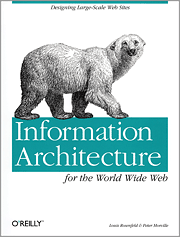Buddhist information architecture (interview with Peter Morville)

An interview with Peter Morville, author of the Information Architecture for the World Wide Web, which has become the reference book for many usability and information architecture specialists. The article has no applied solutions and revolutionary proposals. The author describes his vision of the approach to the process of developing an information architecture and functional elements, which is a kind of synthesis of the traditional approach and various religious and philosophical trends.
Actually, the interview:
The book of the polar bear, according to many, is the bible of information architecture. Officially, it is called the “Information Architecture for the World Wide Web”, but received such a nickname, thanks to the animal depicted on the cover. The book covers everything from navigation to metadata and aesthetics in technical matters. Now, 16 years later, its author Peter Morvil has presented his new book Intertwingled (Interconnection).
You wrote Information Architecture for the World Wide Web in 1998. How has the industry changed over the past 16 years?
')
Since the time of the first edition there have been many changes. Search engines, social networks, mobile Internet, responsive design and many other technologies have a huge impact on the information architecture. I talked about this evolution in Understanding IA . While the Polar Bear talks about fundamental principles that are poorly influenced by time, the approach to organizing the appearance of the information architecture has undergone significant changes.
For example, one of the fundamental principles is that it almost always makes sense to offer the user to get the same information in different ways. The “correct way” depends on the user and the task that he performs. When a visitor knows exactly what he is looking for, he will use the site navigation, but if he is not sure what he needs, he needs a flexible search tool. Of course, the best option is a search that has an effective set of filters and criteria.
However, tools and technologies are constantly changing. These changes led us to a new understanding of what we are doing. Our work is not limited to the Internet, it includes the development of semantic load, space and architecture, which will lead to understanding.
Many people unfamiliar with UX understand the Information Architecture as a subset of UX. How do you see the interaction of I.A. and UX, and at what point are they separate disciplines?
Our tendency to tribalism is dangerous for our professionalism. We differentiate concepts too easily. But, if we are able to adopt a more flexible approach, we will be able to better understand the features of each direction.
On the one hand, the information architecture may be part of the UX, but in another situation, they may change places and the UX will become part of the GI. Although it is much easier to accept one of the theories that describe the relationship between UX and IA, but a deeper understanding of their interaction will allow you to create more interesting and creative solutions.
What do you think, what the main conclusion will be able to make the readers of your book?
E. M. Forster once asked “how can I know what I think until I see what I am talking about?” This simple question uncovers a complex truth that lies in the fact that faith is often shaped by behavior. I hope that my readers will be inspired to dig deeper, because in reality everything is interconnected.
“In recent decades, taking into account the modern features of the cognition process, a thesis has been formed which states that the nature of the mind is largely determined by the body, unlike the computer theory of the mind, which considers the brain as a central processor with inputs (sensors) and outputs (controllers). This approach implies that how and what we think is largely influenced by the processes occurring throughout the body. Our bodies affect the nature and content of our thoughts, and the processing of information extends beyond our brain. In short, knowledge is not only in the head.
In addition, in accordance with the philosophy of consciousness, thinking is not limited to the skin and the skull. Knowledge is formed and distributed in the environment. When we use a pencil to sketch ideas, the pencil becomes an extension of our body, and what we draw affects our thinking. We literally think on paper. According to the scientist Andy Clarke, human cognition includes “feedback, anticipation mechanisms and analysis of the space around the guide: a guide that randomly crosses the boundaries of our brain, body and the world.”
Our tools, like our bodies, must become “transparent equipment”. We need to perceive the task through them. Brain research has shown that when we use tools: pencils, hammers, bicycles, words, numbers, computers — we include them in our body-mind scheme. Then, in accordance with the principle of least effort, we try to distribute the load throughout the system. We use calculators, we unload memory by recording and organizing information, we rely on Google. We also move the mosaic elements in order to understand whether they are suitable for each other or not, as this is easier than presenting the potential result in the mind.
If you still have not read Intertwingled, you can read some of the material here .
Source: https://habr.com/ru/post/240663/
All Articles